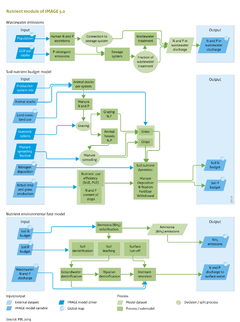Nutrients/Description: Difference between revisions
Jump to navigation
Jump to search
No edit summary |
No edit summary |
||
| Line 51: | Line 51: | ||
# a biologically active layer of 0.3 m thickness is assumed instead of 1 m for other soils; | # a biologically active layer of 0.3 m thickness is assumed instead of 1 m for other soils; | ||
# the approach includes the effect of pH on denitrification. | # the approach includes the effect of pH on denitrification. | ||
====Vegetation in floodplains==== | |||
NPP from the LPJ model for wetlands and floodplains are used. Part of annual NPP is assumed to be deposited in the water during flooding, and where flooding is temporary, the litter from preceeding periods is assumed to be available for transport in the flood water. 50% of total NPP is assumed to end in the surface water. | |||
====In-stream nutrient retention==== | ====In-stream nutrient retention==== | ||
The water that enters streams and rivers through surface runoff and discharges from groundwater and riparian zones is routed through stream and river channels, and passes through lakes, wetlands and reservoirs. The nutrient retention in each of these systems is calculated on the basis of the nutrient spiralling ecological concept, which is based on residence time and temperature as described in ([[Beusen et al., 2014]]; [[Beusen et al., 2015]]). | The water that enters streams and rivers through surface runoff and discharges from groundwater and riparian zones is routed through stream and river channels, and passes through lakes, wetlands and reservoirs. The nutrient retention in each of these systems is calculated on the basis of the nutrient spiralling ecological concept, which is based on residence time and temperature as described in ([[Beusen et al., 2014]]; [[Beusen et al., 2015]]). | ||
}} | }} | ||
Revision as of 14:53, 2 November 2016
Parts of Nutrients/Description
| Component is implemented in: |
| Components: |
| Related IMAGE components |
| Projects/Applications |
| Key publications |
| References |
